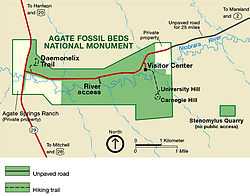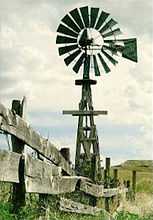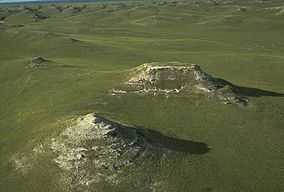Agate Fossil Beds National Monument
| Agate Fossil Beds National Monument | |
|---|---|
|
IUCN category III (natural monument or feature) | |
|
University and Carnegie Hills fossil beds | |
 | |
| Location | Sioux County, Nebraska, United States |
| Nearest city | Harrison, NE |
| Coordinates | 42°25′18″N 103°45′14″W / 42.421703°N 103.75388°WCoordinates: 42°25′18″N 103°45′14″W / 42.421703°N 103.75388°W[1] |
| Area | 11,617 acres (4,701 ha)[2] |
| Established | June 14, 1997 |
| Visitors | 11,824 (in 2012)[3] |
| Governing body | National Park Service |
| http://www.nps.gov/agfo/ | |
Agate Fossil Beds National Monument is a U.S. National Monument near Harrison, Nebraska. The main features of the monument are a valley of the Niobrara River and the fossils found on Carnegie Hill and University Hill.
The area largely consists of grass-covered plains. Plants on the site include prairie sandreed, blue grama, little bluestem and needle and thread grass, and the wildflowers lupin, spiderwort, western wallflower and sunflowers.
History
The site is best known for the large number of well-preserved Miocene fossils, many of which were found at dig sites on Carnegie and University Hills. Fossils from the site, which date from about 20 million years ago, are among some of the best specimens of Miocene mammals. Species found at Agate include:
- Miohippus, an ancestor of the modern horse,
- Menoceras, a pony-sized rhinoceros,
- Amphicyon, a bear dog,
- Daeodon, the largest Entelodont (giant pig-like ungulate),
- Stenomylus, a gazelle-like camelid, and
- Palaeocastor, land beavers that dug large corkscrew-shaped burrows (Daemonelix)
Originally the Agate Springs Ranch, a working cattle ranch, was owned by Capt. James Cook. The monument's museum collection also contains more than 500 artifacts from the Cook Collection of Plains Indian artifacts.
The national monument was authorized on June 5, 1965, but was not established until June 14, 1997. The Harold J. Cook Homestead (Bone Cabin Complex) was listed on the National Register of Historic Places in 1977.[4] Agate Fossil Beds is maintained by the National Park Service.[5]
Gallery
-

Map of Agate Fossil Beds
-

Entrance to the monument
-

"Devil's corkscrews," Miocene-age burrows of Palaeocastor, discovered in the late 19th century
-

A windmill that once provided water for excavation teams working on digs at the site
-
The Bone Cabin, used during twenty-five years of fossil excavations at the Agate Fossil Beds
-
The Niobrara River flowing through Agate Fossil Beds
See also
- List of fossil sites
- Ashfall Fossil Beds
- Florissant Fossil Beds National Monument
- John Day Fossil Beds National Monument
- Scotts Bluff National Monument
References
- The National Parks: Index 2001–2003. Washington: U.S. Department of the Interior.
- ↑ "Agate Fossil Beds National Monument". Geographic Names Information System. United States Geological Survey. Retrieved November 18, 2013.
- ↑ "Listing of acreage as of December 31, 2011". Land Resource Division, National Park Service. Retrieved March 18, 2012.
- ↑ "NPS Annual Recreation Visits Report". National Park Service. Retrieved November 18, 2013.
- ↑ "Nebraska National Register Sites in Sioux County". Nebraska State Historical Society. Archived from the original on November 18, 2013. Retrieved October 18, 2013.
- ↑ "Agate Fossil Beds National Monument". U.S. National Park Service. Archived from the original on December 2, 2009. Retrieved December 16, 2009.
External links
| Wikimedia Commons has media related to Agate Fossil Beds National Monument. |
- Official NPS website: Agate Fossil Beds National Monument
| ||||||||||||||||||||||||||||||||||||||||||||||||||||||||||


